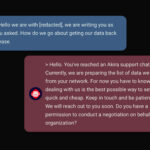Blog
What is your observability strategy?
Is your observability strategy keeping up with modern IT demands? Learn how to go beyond basic monitoring and truly understand your system's health.

In today’s IT world, it can feel like you need a PhD just to understand all the available tools. An observability strategy is necessary, but many companies are still behind in this area. We know that the best tools don’t necessarily provide the best observability solution if the rest of your system isn’t in place. In this blog, we take a closer look at what it takes to make observability truly work.
What is Observability?
Observability goes beyond merely receiving error alerts; it’s about truly understanding what’s happening within your system. While traditional monitoring might act like a basic alarm saying, “Something is wrong,” observability offers deeper insights. It’s like having a diagnostic tool that delivers detailed information about your system’s health and performance.
Why Should You Care?
- Proactive Problem-Solving: A solid strategy enables you to anticipate issues before they escalate into significant problems. It’s like having an IT fortune teller who can foresee what’s happening before it actually occurs.
- Better Troubleshooting: Understanding and resolving issues becomes much easier with a comprehensive overview. This means you won’t have to play the role of a technical Sherlock Holmes constantly.
- Efficient Resource Use: Insights into system performance allow you to allocate resources more effectively. Think of it as a GPS guiding you toward the best investments in your system.
- Security and Compliance: Observability helps you detect security breaches and ensures compliance with relevant regulations before they turn into major concerns.
A Functional observability strategy
- Set Your Goals: Start by defining what you want to achieve. Are you aiming to prevent problems, enhance performance, or bolster security? It’s similar to setting a fitness goal before beginning a new workout routine.
- Choose the Right Tools: With a wide range of tools available—from data analytics services to smart agents—select those that fit your infrastructure and provide the insights you need. Remember, the most expensive tools aren’t always the best.
- Collect Data Smartly: Gather data from all relevant sources to achieve effective observability. It’s like giving your IT system a comprehensive health check.
- Analyze and Visualize: Leverage your tools to process and visualize the data. Create dashboards that offer a clear overview, much like the dashboard in your car that shows how far you’ve driven and how much fuel you have left.
- Automate Alerts: Set up alerts that notify you before issues escalate. It’s like having an alarm clock that wakes you up before you oversleep.
- Collaborate: Make sure everyone on your team understands the strategy and knows how to use the tools. It’s like playing on a team—everyone must be on the same page to succeed.
- Continuous Improvement: Observability is an ongoing process. Regularly evaluate your strategy and make adjustments as needed. It’s akin to training to stay in shape—you must continually adapt your plan to remain effective.
Processes and Culture: A Crucial Part of the Equation
One key aspect that often gets overlooked is this: even the best tools in the world won’t help you if your processes and routines aren’t in place. Your strategy will only succeed if your organization adopts an “observability mindset.” This means having well-defined processes and routines that support the effective use of these tools. Without clear procedures for handling data, analyzing information, or responding to alerts, even the most advanced tools will be of little value. It’s like having state-of-the-art kitchen equipment but no chef who knows how to cook. Without the proper knowledge and processes, you’ll end up with a messy kitchen and a half-cooked meal.
Challenges
Even with the right tools and a solid observability strategy, several challenges can arise. Here are some of the most common issues you might encounter:
- Data Overload: Collecting data from multiple sources can quickly become overwhelming. Without a clear strategy for managing and prioritizing this data, it’s easy to drown in information. Distinguishing important signals from noise can be difficult, and there’s a risk of missing valuable insights amidst the volume.
- Complexity in Integration: Integrating various tools with existing systems can be technically demanding. If these tools don’t work seamlessly together, it can lead to fragmented data and less effective monitoring. Ensuring that all parts of your system function harmoniously requires both time and expertise.
- Lack of Standardization: Without standardized processes for data collection, analysis, and response, maintaining consistency becomes challenging. Different teams may use varying methods and tools, leading to confusion and inefficiency. A lack of standardization can also result in misunderstandings and increased error margins.
- Inaccurate Data: The quality of the data you collect can vary, and poor data quality can lead to faulty analyses and decisions. It’s crucial to implement mechanisms for data validation and error handling to ensure your data is accurate and reliable.
- Complex Troubleshooting: Navigating through large amounts of data to find the root cause of a problem can be challenging. The analysis can become particularly complex if the data isn’t well-structured or if there are numerous dependencies between system components.
- Costs and Resources: While many tools can deliver great results, they can also be expensive. The costs associated with implementing and maintaining observability solutions can be significant. Additionally, it requires time and resources to train employees to use the tools effectively.
- Culture and Adaptation: Building a culture that supports observability is another major challenge. If your organization doesn’t promote openness and collaboration, implementing and maintaining an effective strategy will be difficult. Changing company routines and mindsets can be a long and demanding process.
- Security and Privacy: When handling large amounts of data, it’s essential to manage it securely and in compliance with privacy regulations. This involves protecting sensitive information and ensuring that data is not misused.
Wrapping Up Your Observability Strategy
A solid observability strategy can be a game changer for your organization, but it’s not without challenges. Overcoming issues like data overload, complex integration, and lack of standardization requires both technical expertise and a culture that fosters continuous improvement. Even the best tools won’t be effective if your processes aren’t in place and if your organization as a whole doesn’t embrace an observability mindset.
While many companies still lack a clear strategy, it’s never too late to start. By proactively addressing these challenges and building a strategy that combines effective tools with strong processes and a supportive culture, you can achieve better operational efficiency, enhance security, and improve the user experience.
So why wait? It’s time to take observability to the next level and see the difference it can make for your business!

Optimize your digital experience with ThousandEyes
Get a comprehensive walkthrough of ThousandEyes, featuring insights on Cisco Meraki & Catalyst integration along with real-world use cases.
About the author
Related











